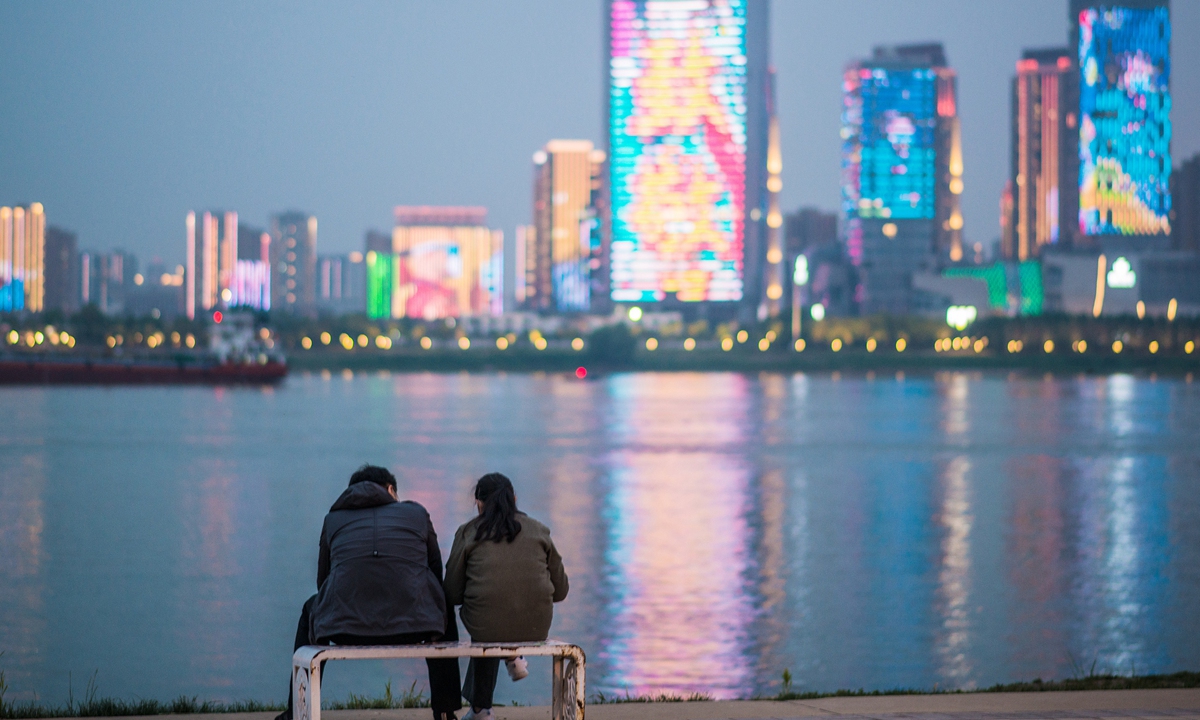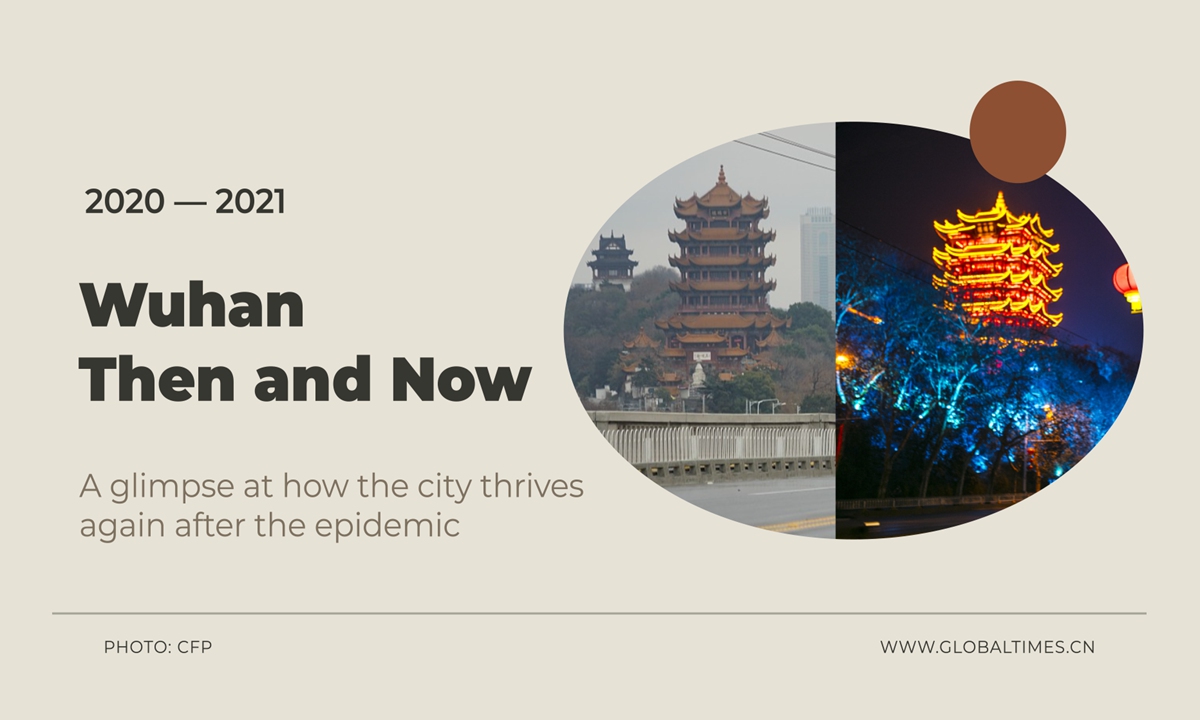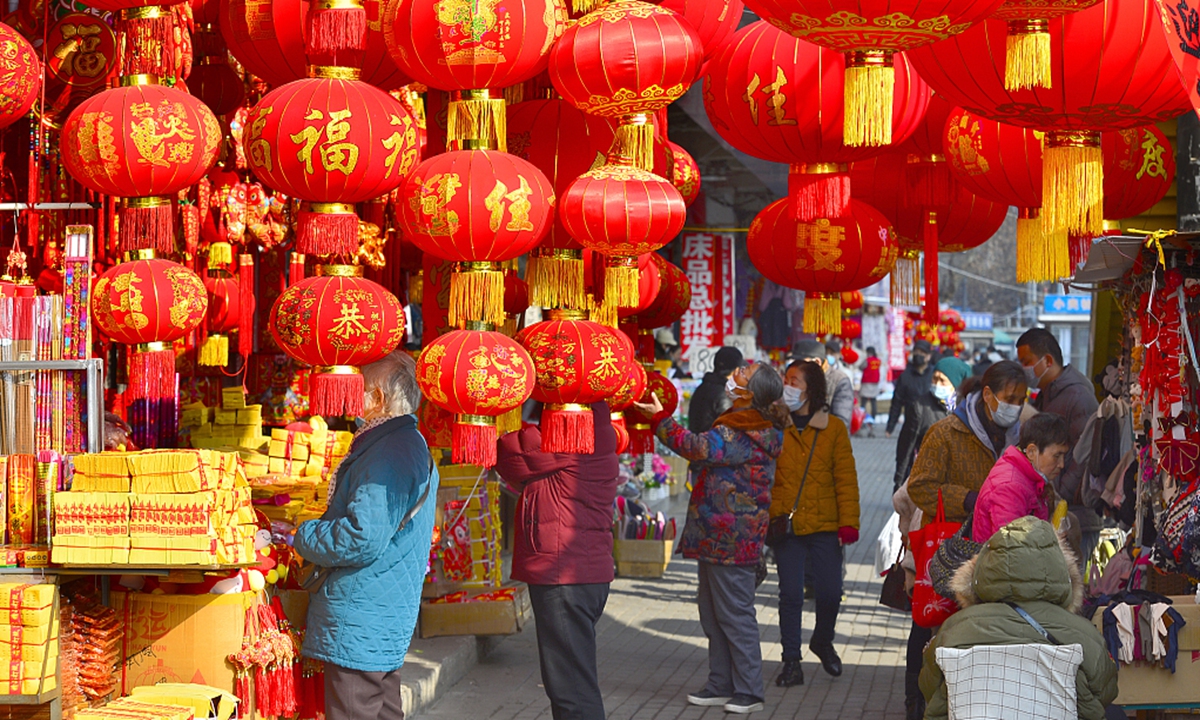IN-DEPTH / IN-DEPTH
Unforgettable moment - how non-COVID patients weathered Wuhan epidemic

Two people enjoy a Wuhan evening on April 23. Photo: VCG
Turning back the clock to exactly one year ago - the city of Wuhan, Central China's Hubei Province, was badly hit by an unknown contagious virus. The city went into a historic lockdown on January 23, 2020.
The city's overwhelming efforts to curb the spread of the virus and all-out efforts to help the COVID-19 patients, however, made it a bit difficult for another group of patients - non-COVID patients.
Those were indeed painful days for the non-COVID patients and their families in Wuhan. Some were hit by unforeseen losses. They were too upset to realize that even in the darkest hours, no citizen was ever alone.
As the city stepped out of the shadow, Wuhan quickly provided multifaceted support for this group. Community workers were always there together with medical workers and the local government. Since then, other cities in China have learned from Wuhan's lessons to safeguard the city's overall allocation of medical resources in times of COVID-19 outbreaks.
If another acute epidemic strikes, China's cities can certainly do better, but some similar preventive measures will still be inevitable, experts told the Global Times.
'A painful but right choice'
The lockdown was aimed at "suffocating the virus within the city." Before the city reopened in April 2020, it had reduced the number of COVID-19 cases in China by 96%. In the most critical moment for the city, it saved the lives of most of its citizens.
However, those who were trapped in Wuhan with other diseases in late January, 2020, recalled to the Global Times the initial days of the lockdown as "the darkest hours."
"It was a painful choice, but the right thing to do," Yang Zhanqiu, a Wuhan-based virologist, said after a prolonged silence, recalling the dilemma of resource allocation when the city crashed into darkness
Hospitals were operating under high pressure. According to the data released by the Hubei Health Commission in February, more than 92 percent of the beds at Wuhan's COVID-19 designated hospitals were used for treating the confirmed cases and isolating those suspected of being infected with the disease.
"At the peak of the outbreak, the volume of resuscitation was about one-third of the normal time, including the emergency treatment for COVID-19," Xia Jian, deputy director of the emergency center at the Wuhan University Zhongnan Hospital, said.
"There were just not enough medical workers left to provide care for other patients," Zhou Ning, a frontline doctor from the Tongji Hospital in Wuhan told the Global Times. The cardiologist noted that most of the doctors and nurses were sent to the front line, including him, regardless of which field they specialized in.
"And there would be no safe place anywhere for other patients, as the whole hospital had become a high-risk COVID-19 infection zone," he said.
Long-term treatments were suspended. Emergency care was downsized. Suburban patients were not allowed to enter the city. According to a report by the Xinhua News Agency, more than 400,000 patients with serious and chronic diseases in Wuhan faced difficulties in purchasing drugs. As more and more COVID-19 patients were recovering, the city's medical system was sending an alarm.
Never forgotten
Wuhan resident Gong Chunfan said her mother had been under chemotherapy for lymphomatosis for half a year at the Tongji Hospital in Wuhan and was scheduled to receive a surgery around the time when the city entered the lockdown.
Her mother's surgery had to be suspended, as her attending doctors were sent to the anti-epidemic front line. At the same time, her mother was transferred to an isolation ward as a suspected case of COVID-19, though she later tested negative for the virus.
Gong and the family were not allowed to visit her mother at the hospital due to COVID-19 concerns. "I texted her every day, encouraging her to hold on. She would always reply 'don't worry, I will'," Gong said, "That really tore my heart apart."
In despair, Gong turned to the internet for help. On February 6, she wrote a post on China's Twitter-like microblogging platform Sina Weibo, illustrating her mother's situation to the wider public in the hope of help. Her posts were forwarded by more than 100 netizens.
In late January and early February, thousands of posts describing similar situations as Gong's flooded Sina Weibo. Topics related to Wuhan's non-COVID patients received 160 million views and 150,000 discussions.
Grievingly, it was too late and she lost her mother to hemophagocytic lymphohistiocytosis on February 19. However, many other messages were picked up.
This group in need was quickly noticed by journalists. Multiple media outlets called for attention and help for the patients. Civilian help and official support also followed.
Zhan Bing, a Wuhan local and initiator of the volunteer service center Qingchun Feiyang in Xinzhou district, said his team had received a number of requests for help from such patients.
Zhan and other volunteers would transport these patients in and out of the community, deliver their medications, and coordinate hospital beds for them.
There were times when there were no available beds even after searching all over the city, Zhan told the Global Times. "Still, we tried to do everything we could to help them."
Wuhan 520 Volunteer Organization was another social group that was helping the non-COVID patients. They helped coordinate with a number of out-of-town hospitals and assisted with the procedures to transfer some patients to other cities during the period.
Cai Zhongxiang, a doctor at the Renmin Hospital of Wuhan University, negotiated with multiple parties to open up a green channel for the non-COVID patients, and ensured 223 patients completed their treatment on schedule, media reported.
The Wuhan municipal government also assisted the non-COVID patients in other ways during the period. Organized by the municipal government, each community recruited drivers on online car-hailing platforms to form a group providing services to the residents.
Liu Peng, a car owner who participated in the program, told the Global Times that at that time, the team often provided transportation services for all kinds of patients, many of whom were non-COVID patients, for medical treatment.
"The government provided the owners with a full set of protective materials, and disinfection work had to be done every time they left the car, some days more than a dozen of times. Drivers would work in shifts to ensure the service was always available," Liu told the Global Times.
Companies like Didi had organized 1,600 drivers and provided nearly 150,000 trips for 402 communities during the period between January and April 2020, under the overall arrangement of the Hubei government, thepaper.cn reported.
A Wuhan official who requested anonymity told the Global Times that grassroots officials in Wuhan were also quick to take note of the plight of these residents.
"At the time, many patients who needed dialysis were experiencing great difficulty because the hospital they normally went to was designated for COVID-19 treatment," the official said, "Community officials would help these people find vehicles as well as contact other hospitals for admission."
I particularly remember our assistance to a pregnant woman, he said. She was in labor but was diagnosed with COVID-19, and the hospitals' gynecology department could not admit her.
"The community officials reported the situation directly to the district government and the district anti-epidemic command assigned the receiving hospital directly to her," he recalled, "It was stressful, but with the cooperation of multiple parties, both mother and child were eventually discharged safely."
A few days later, the number of posts asking for help decreased, while there were more follow-up posts sharing happiness of being cured.
Cheng Sheng, a resident from Daye, Hubei, was one of them. Cheng got a phone call from a residential community staff in Wuhan's Hankou district immediately after he posted about his father-in-law needing help due to a cardiac failure on March 6. The staff instructed him to get an entry pass to Wuhan for his in-law and provided other instructions that helped him to stay in a hotel and get admitted to a hospital there.
"We felt quite surprised how smooth everything went. The government system [offering medical aid] seemed to have resumed and been functioning well," he said.
On February 16, the Wuhan Health Commission first announced six designated hospitals for non-COVID-19 patients, including one for emergency, three for hemodialysis, one for maternal and child care, and one for cardiovascular, cerebrovascular, hypertension and diabetes.
Two days later, the number of such hospitals tripled covering more kinds of diseases, such as malignant tumor and ear, nose and throat diseases. The hospitals were freed up as more COVID-19 patients were cured.
"Every patient should be treated on time," said Wang Xiaodong, governor of Hubei Province in February 2020, urging to arrange more medical resources for non-COVID patients.
A lesson from Wuhan
After the initial peak of the COVID-19 outbreak, many cities learned lessons from Wuhan in terms of supporting non-COVID patients and taking corresponding safeguards in subsequent domestic outbreaks.
On February 25, Wuhan's neighboring city Xiangyang followed Wuhan's lead and opened over 80 specialized medical facilities for non-COVID patients, and also proposed a procedure for their seeking medical service, which basically met the emergency needs of special patients. Other Hubei cities also took similar initiatives.
Subsequently, cities across China, including East China's Shanghai and Southwest China's Chengdu, enhanced outpatient appointment system and community pharmacies delivering medications to patients.
In August 2020, the northeastern city of Dalian saw rebounds of COVID-19. While all efforts were made to prevent and control the outbreak, government departments made arrangements for the referral and treatment of non-COVID patients at the same time.
In January 2021, when the city of Shijiazhuang, North China's Hebei Province, saw the largest cluster outbreak in China in recent months, government departments made a point of emphasizing the opening of green channels for non-COVID patients to seek medical care, China News Service reported.
"At a later stage, many cities have opened emergency green channels to facilitate direct access to patients with acute illnesses. For acute patients who have not yet undergone nucleic acid testing, hospitals have also opened special isolation wards for their first admission. For patients with chronic diseases, services such as remote prescription and advance medication pickup are also available," Bai Wenpei, chief physician at the Beijing Shijitan Hospital, told the Global Times.
Overall, this public health emergency event has also advanced China's healthcare system as a whole, such as the further implementation of the appointment-based hospital system, the greater importance of internet-based healthcare, and the access of community pharmacies to healthcare services.
But one of the big reasons other cities were able to do a good job of covering themselves accordingly is that they didn't experience a large outbreak as Wuhan did initially, Bai said. Due to the high mortality rate among critical COVID-19 patients and the highly contagious nature of the disease, Wuhan's top priority at the time was to clear the virus, which could otherwise have led to extremely serious consequences.
If an epidemic strikes again, China's cities can certainly do better, but some mandatory preventive measures will still be inevitable, in order to keep the vast majority of people safe, Bai noted.
"What I can guarantee is what any health worker has always upheld and will always uphold - the 'life first' credo. We will abandon no one." she said.
Sidenote: How Wuhan makes things right
Even before the city was freed from the COVID-19 mushroom cloud, it was quickly awakened to the plight of the previously neglected non-COVID patients.
Wang Xiaodong, governor of Hubei province and head of the provincial epidemic prevention control work, urged to arrange more medical resources for non-COVID-19 patients at a meeting on February 20, just two days after the number of hospitalized COVID-19 patients in Wuhan peaked at 38,020.
On February 16, the Wuhan Health Commission first announced six designated hospitals for non-COVID-19 patients, including one for emergency, three for hemodialysis, one for maternal and child care, and one for cardiovascular, cerebrovascular, hypertension and diabetes.
Two days later, the number of such hospitals tripled covering more kinds of diseases, such as malignant tumor and etological diseases.
The hospitals were freed up as more COVID-19 patients were cured, and Wuhan's 16 Fangcang makeshift hospitals and Huoshenshan and Leishenshan emergency specialty field hospitals were gradually put into use. The city's regular medical care system gradually got back on track.
More than 40,000 medical workers from other places in China had been sent to aid Wuhan by March, which greatly solved the problem of staffing shortage for the treatment of non-COVID-19 patients.
The Wuhan Health Commission started to publish information regarding the admission and treatment of non-COVID-19 patients on March 16, including the list of hospitals for patients with different categories of diseases and the number of beds available.
The information had been updated on a daily basis on the website through March and April.
On April 8, Wuhan stepped out of the historic lockdown. Wuhan citizens embraced new rays of sunshine, although some of them were left in the winter.
As of April 10, Wuhan had cumulatively completed the restoration of 66 large and medium-sized hospitals with 35,000 open beds for non-COVID patients. A total of 66 hospitals have a single-day emergency outpatient capacity of more than 50,000.
On April 26, Wuhan declared an end to the more than three months of intense battle against the virus, with all hospitalized COVID-19 patients cured and discharged. A total of 69 medical institutions had been reopened for normal patients in the city by April 30.
Yuan Ruiqi also contributed to this story.


